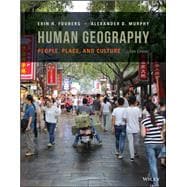Fouberg/Murphy: Human Geography: People, Places, and Culture 12th edition teaches students to appreciate the diversity of people, places, and cultures, and understand the role people play in shaping our world. The goals of this edition are to provide geographic context to global, regional, national and local issues and to teach students to think geographically and critically about these issues. Human Geography features beautifully designed maps, dozens of vibrant photographs taken by the author team, and author and guest field notes that help students see how geographers read cultural landscapes and use fieldwork to understand places.
Fouberg’s Human Geography, 12th Edition now integrates Threshold Concepts to help students develop their ability to think geographically. Once they learn and apply one of these concepts in the context of a given place, students integrate it into their thinking and can draw from it as they learn new material and explore other places.
1 Introduction to Human Geography 1
1.1 Define Human Geography and Describe the Value of Thinking Geographically 2
1.2 Identify and Explain Geography’s Core Concepts 7
1.3 Identify Types of Maps and Examine the Role Maps Play in Understanding the World 21
1.4 Describe How Culture Influences Patterns and Processes in Human Geography 27
2 Population and Health 31
2.1 Describe the Patterns of Population Distribution 32
2.2 Identify and Explain Influences on Population Growth over Time 36
2.3 Explain How Health and Disease Affect Peoples’ Well-Being 48
2.4 Identify Why and How Governments Influence Population Growth 57
3 Migration 62
3.1 Explain Migration as a Type of Movement 63
3.2 Explain Historic and Modern Forced Migration 73
3.3 Explain the Theories of Migration and Understand the Motivations for Migration 77
3.4 Identify Why Refugees are a Distinct Group of Migrants and Describe Where Most Refugees Migrate 83
3.5 Determine How Government Policies Impact Migration 90
4 Local Culture, Popular Culture, and Cultural Landscapes 97
4.1 Explain Local Cultures and Popular Culture 98
4.2 Understand How People Sustain Local Cultures in Rural and Urban Areas 100
4.3 Explain How Global, Popular Culture is Created and Diffused 110
4.4 Compare and Contrast How Local and Popular Cultures are Reflected in Cultural Landscapes 119
5 Identity: Race, Ethnicity, Gender, and Sexuality 127
5.1 Define Identity and Explain How Identities are Constructed 128
5.2 Determine How Place Affects Identity and How We Can See Identities in Places 133
5.3 Explain the Role Structures of Power Play in Shaping Identities 140
6 Language 156
6.1 Define Language and Describe the Role of Language in Culture 157
6.2 Explain How Languages are Related and Distributed 161
6.3 Explain How Language Can Be Used as a Unifying or Dividing Force 172
6.4 Determine the Role Language Plays in Making Places 177
7 Religion 186
7.1 Describe the Nature of Religion and Its Cultural Significance 187
7.2 Describe the Distribution of Major Religions and the Factors That Shaped Their Diffusion 190
7.3 Explain How the Cultural Landscape Reflects Religious Ideas and Practices 205
7.4 Identify and Describe the Role Religion Plays in Political Conflicts 213
8 Political Geography 225
8.1 Compare and Contrast States, Nations, and Nation-States 226
8.2 Determine How the Modern Political Map Evolved 232
8.3 Explain the Nature and Significance of International Boundaries 242
8.4 Explain Classical and Critical Geopolitics 248
8.5 Compare and Contrast Supranational Organizations and States 252
9 Urban Geography 261
9.1 Describe the Sites and Situations of Cities 262
9.2 Analyze the Distribution of Cities and Their Relative Size 272
9.3 Explain the Internal Structure of Cities and Compare Urban Models 276
9.4 Analyze How Political and Economic Policies Shape Cities 282
9.5 Explain What World Cities are and Describe How They Shape and Reflect Globalization 290
10 Development 301
10.1 Explain How Development is Defined and Measured 302
10.2 Describe the Nature and Limitations of Development Models 307
10.3 Explain Major Influences on Development 311
10.4 Evaluate How Political and Economic Institutions Influence Uneven Development Within States 320
11 Agriculture 327
11.1 Compare and Contrast the Three Agricultural Revolutions 328
11.2 Describe the Spatial Patterns of Agriculture 341
11.3 Explain the Map of Global Agricultural Production 347
11.4 Analyze How Commercial Agriculture Operates 353
11.5 Examine the Challenges of Feeding Everyone 361
12 Industry and Services 371
12.1 Describe the Hearth and Diffusion of the Industrial Revolution 372
12.2 Explain How and Why the Geography of Industrial Production Has Changed 379
12.3 Explain Global Patterns of Industrial Production 388
12.4 Determine How Deindustrialization and the Rise of Service Industries Have Changed the Economic Geography of Trade 395
13 The Humanized Environment 403
13.1 Explain What Natural Hazards are and How Natural Hazards Can Become Natural Disasters 404
13.2 Identify the Ways That Humans Impact Earth Through Land Use, Water Use, and Resource Extraction 411
13.3 Explain How Climate Change is Impacting Human–Environment Interactions 419
13.4 Explain How Human Consumption is Changing the Scale of Human Impact and Challenging Sustainability 423
14 Globalization and the Geography of Networks 434
14.1 Describe How Identities are Changing in a Globalized World 435
14.2 Identify Networks and Explain Their Role in Globalization 438
14.3 Explain How Social, Information, and Economic Networks Operate in a Globalized World 441
Appendix A Maps A-1
Appendix B Area and Demographic Data B-1
Appendix C Answers to Self-Tests C-1
Appendix D References* D-1
Glossary G-1
Index I-1

